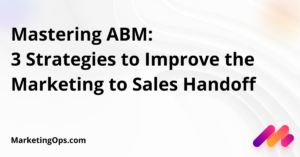One morning, you wake up to the news that your company has acquired another business. You’re tasked with initiating discussions on integrating the acquired company’s data and tools into your existing processes and workflows. Having encountered similar situations countless times in my career as a Marketing Ops professional, I’ve developed a systematic approach to guide you through the process. Performing thorough discovery, identifying key stakeholders, and determining a timeline are key to executing a successful migration.
Why a Defined Process is Important
The Marketing Ops team may be pressed to perform integration as quickly as possible while wearing dual project management hats but having defined and strategic steps should be viewed as a necessity instead of a roadblock. A successful integration impacts everything from business continuity, the accuracy of actionable data and preserves the ability to make business decisions.
Preparing for Migration
Having a solid understanding of the acquisition company’s data and tools is crucial to a successful integration.
- People: When identifying the stakeholders you will be working with, ensure they have admin access to the tools and have a deep understanding of the data – go direct to the source and eliminate the “middleman”.
- Process: Data acquisition is the most important part of this conversation and questions should be asked about how data comes into the database, if explicit consent is being captured and how opt-outs are processed.
- Tools: Determine what tools are in both the sales and marketing technology stack along with any other tools they integrate into. If there are overlapping tools a decision will need to be made on contract retention.
Assess the Data & Tools
- Evaluate the quality, origin and completeness of data and the percentage of overlap (if any) between your data and the acquisition company data.
- Document all tools in the acquisition company that fall under marketing. Include any overlapping tools with sales/sales ops/sales enablement that impact marketing along with contract renewal dates. It may be helpful to use products like MartechGuru, CabinetM, or just an old-fashioned Spreadsheet to document the stack and even the people involved.
- Establish clear objectives with defined goals and desired outcomes along with identifying deliverable dates.
Build a Cross-Functional Team
- Identify areas of the acquisition company that are crucial to migration success and determine who the key contacts are that will act as the liaison.
- Ensure that periphery departments that may not interface with sales and marketing on a regular basis are considered, such as IT, Finance and HR.
- Determine a meeting cadence and project management platform that will be used to house and document all decisions.
Data Mapping and Standardization
This will look different depending on how complex the business on both sides are but in general, a good starting point looks like this:
- General discovery (how many contacts in DB, how many leads per day, week, month)
- Define how new contacts/prospects are being fed into the database
- Determine if new leads from the acquisition company should go directly into your CRM
- Identify any routing rules that need to be in place if the above is true
- Work with Sales Operations to add the relevant fields to impacted objects in your CRM
- Identify any specific market segments that aren’t currently covered by your picklist
- Create a way to capture leads from the acquisition company website by implementing a form that feeds directly into your marketing automation platform
- Define the existing acquisition company database and how contact data is stored
- Extract prospect data with as much information as possible for review
- Match the prospect data against what is currently in your database
- Ensure data is standardized in a format and structure
- Understand what data compliance looks like (CASL, GDPR, etc – work with your legal team on this)
A Phased Migration Approach
Balancing a business vs a realistic timeline to migration can be a challenge but having defined steps can help to group tasks into specific deliverables while working back from a go-live date. Some things to consider when creating your project plan:
- Understand when acquisition customer data will be put into your CRM and then sync to your marketing automation tool
- Create a migration campaign for migrated opportunities to be tagged to
- Create a migration campaign for migrated leads to be tagged to
- Extend all existing reports to start pulling in all acquisition company leads and opportunities
- Provide the acquired marketing team with end-to-end information and training on processes and begin running campaigns
- Determine a cut-over date for when the DB will be migrated and all lead sources funneled into your MAP
- Process and consolidate opt-outs for a period of time between the two databases. Note: When emails start going out of your MAP they should be stopped in the acquisition company.
Potential Challenges
- Inconsistent data formats, structures, and quality between the acquisition company and your company can lead to errors, inaccuracies, and misinterpretation of information.
- Complexity in integrating different systems, databases, and technologies from the merging entities.
- Ensuring the security of sensitive data during the migration process is key to minimizing any data security risks. Data breaches, unauthorized access, and non-compliance with data protection regulations are risks to the business that need to be avoided.
- Pushback from employees and stakeholders accustomed to existing processes and tools can lead to slower-than-expected adoption and trigger potential productivity dips.
- Conflicting contracts with tools may lead to a period of double-dipping or paying for two identical systems in parallel.
With any major undertaking that involves large amounts of data and integrated systems, business continuity and minimal disruption should be top of mind. Having a well-executed migration plan reduces the long-term costs associated with data discrepancies, lack of technology adoption and costs associated with unneeded peripheral tools.







